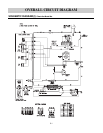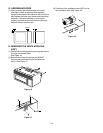
MEASUREMENT WITH THE OUTER CASE
REMOVED
(1) When you replace the magnetron, measure for
microwave energy leakage before the outer case
is installed and after all necessary components
are replaced or adjusted. Special care should be
taken in measuring the following parts.
- Around the magnetron
- The waveguide
WARNING: AVOID CONTACTING ANY HIGH
VOLTAGE PARTS.
MEASUREMENT WITH A FULLY
ASSEMBLED OVEN
(1) After all components, including the outer
panels, are fully assembled, measure for
microwave energy leakage around the door
viewing window, the exhaust opening and air
inlet openings.
(2) Microwave energy leakage must not exceed the
values prescribed below.
NOTES:
Leakage with the outer panels removed - less
than 5 mW/cm
2
.
Leakage for a fully assembled oven (“Before the
latch switch (primary) is interrupted”) with the door
in a slightly opened position - less than 2 mW/cm
2
.
NOTE WHEN MEASURING
(1) Do not exceed meter full scale deflection.
(2) The test probe must be removed no faster than
1 inch/sec (2.5cm/sec) along the shaded area,
otherwise a false reading may result.
(3) The test probe must be held with the grip portion
of the handle. A false reading may result if the
operator’s hand is between the handle and the
probe.
(4) When testing near a corner of the door, keep
the probe perpendicular to the surface making
sure the probe horizontally along the oven
surface, this may possibly cause probe damage.
RECORD KEEPING AND NOTIFICATION
AFTER MEASUREMENT
(1) After adjustment and repair of any microwave
energy interruption or microwave energy blocking
device, record the measured values for future
reference. Also enter the information on the
service invoice.
(2) Should the microwave energy leakage not be
more than 2 mW/cm
2
after determining that all
parts are in good condition, functioning properly
and genuine replacement parts which are listed in
this manual have been used.
(3) At least once a year, have the electromagnetic
energy leakage monitor checked for calibration
by its manufacturer.
(1) Microwave power output measurement is made
with the microwave oven supplied at its rated voltage and
operated at its maximum microwave power setting with a
load of (1000±5) g of potable water.
(2) The water is contained in a cylindrical borosilicate
glass vessel having a maximum material thickness
of 1/8" (3 mm) and an outside diameter of approximately
7.6" (190mm).
(3) The oven and the empty vessel are at ambient
Temperature(T0) prior to the start of the test.
(4) The initial temperature (T1) of the water is
(10±1)°C (50°F). It is measured immediately before the
water is added to the vessel. After addition of the water to
the vessel, the load is immediately placed on the center
of the turntable which is in the lowest position and the
microwave power switched on.
(5) The time T for the temperature of the water to rise
by a value ∆T of (10±1)°K is measured, where T is the
time in seconds and ∆T is the temperature rise.
The initial and final water temperatures are selected so
that the maximum difference between the final water
temperature and the ambient temperature is 5°K.
(6) The microwave power output P in watts is calculated
from the following formula :
4187 Mw(T2 –T1)+0.55Mc(T2 –T0)
T
is measured while the microwave generator is
operating at full power. Magnetron filament heat-up
time is not included. (about 3 sec)
(7) The water is stirred to equalize temperature
throughout the vessel, prior to measuring the final
water temperature.
(8) Stirring devices and measuring instruments are
selected in order to minimize addition or removal of
heat.
7-3
POWER OUTPUT MEASUREMENT
P =
WATER LOAD
TURNTABLE
Where
P is the microwave power output, in watts:
Mw is the mass of the water, in grams:
Mc is the mass of the container, in grams:
T0 is the ambient temperature, in ¡C:
T1 is the initial temperature of the water, in ¡C:
T2 is the final temperature of the water, in ¡C:
t
is the heating time in seconds, excluding the magnetron filament heat- up time.


















